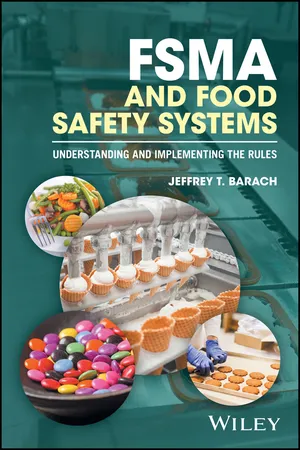
- English
- ePUB (mobile friendly)
- Available on iOS & Android
About this book
The FDA's (Food and Drug Administration) FSMA (Food Safety Modernization Act) is the most sweeping reform of United States food safety laws in more than 70 years. The key to successful implementation of FSMA rules depends on building a comprehensive Food Safety System with effective prerequisite programs in place and a well-designed Food Safety Plan that incorporates risk-based preventive controls to mitigate hazards.
This book provides essential guidance for small to mid-sized businesses on how to design, implement, and maintain a world-class Food Safety Plan that conforms to FSMA regulations. With practical and up-to-date advice, the author offers a straight forward approach for readers to successfully migrate into FSMA. The inclusion of fully developed Food Safety Plans as well as examples of hazards and preventative controls make this a must-read not only for those that are new to the regulations, but also those with a plan already in place.
FSMA and Food Safety Systems: A Guide to Understanding and Implementing the Rules is an indispensable resource for all those managing the manufacture of FDA regulated products, food safety regulators and educators, as well as scientists and students of food science and technology.
Frequently asked questions
- Essential is ideal for learners and professionals who enjoy exploring a wide range of subjects. Access the Essential Library with 800,000+ trusted titles and best-sellers across business, personal growth, and the humanities. Includes unlimited reading time and Standard Read Aloud voice.
- Complete: Perfect for advanced learners and researchers needing full, unrestricted access. Unlock 1.4M+ books across hundreds of subjects, including academic and specialized titles. The Complete Plan also includes advanced features like Premium Read Aloud and Research Assistant.
Please note we cannot support devices running on iOS 13 and Android 7 or earlier. Learn more about using the app.
Information
1
What is Modern Food Safety, and How is that Different from HACCP?
1.1 Introduction
- Evaluating the hazards that could affect food safety;
- Specifying what preventive steps, or controls, will be put in place to significantly minimize or prevent the hazards;
- Specifying how the facility will monitor these controls to ensure they are working;
- Maintaining routine records of the monitoring, and
- Specifying what actions the facility will take to correct problems that arise.
- A written food safety plan;
- Hazard analysis;
- Preventive controls;
- Monitoring;
- Corrective actions and corrections;
- Verification;
- Supply‐chain program;
- Recall plan; and
- Associated records.
1.2 FSMA Sanitation and cGMPs
21 CFR Part 117 (Subpart B) – Current Good Manufacturing Practices
- Part 117.10 Personnel
- Part 117.20 Plant and grounds
- Part 117.35 Sanitary operations
- Part 117.37 Sanitary facilities and controls
- Part 117.40 Equipment and utilities
- Part 117.80 Processes and controls
- Part 117.93 Warehousing and distribution
- Part 117.95 Holding and distribution of human food by‐products for use as animal food
- Part 117.110 Defect action levels
1.3 FSMA Preventive Controls
Table of contents
- Cover
- Title Page
- Table of Contents
- Preface
- About the Author
- 1 What is Modern Food Safety, and How is that Different from HACCP?
- 2 Why Is a Food Safety System the Best Path to Food Safety?
- 3 What are the Essential Elements of a Food Safety System?
- 4 How is a Food Safety System Managed?
- 5 How is a Food Safety System Developed and Implemented?
- 6 What Triggers a Reanalysis of the Food Safety Plan?
- 7 Resources for Preparing Food Safety Preventive Controls Plans
- 8 Example Food Safety Plans
- 9 FSMA Regulations
- Appendix A: Food Safety Plan Checklist
- Appendix B: HACCP Principles and Application Guidelines
- Glossary
- End User License Agreement